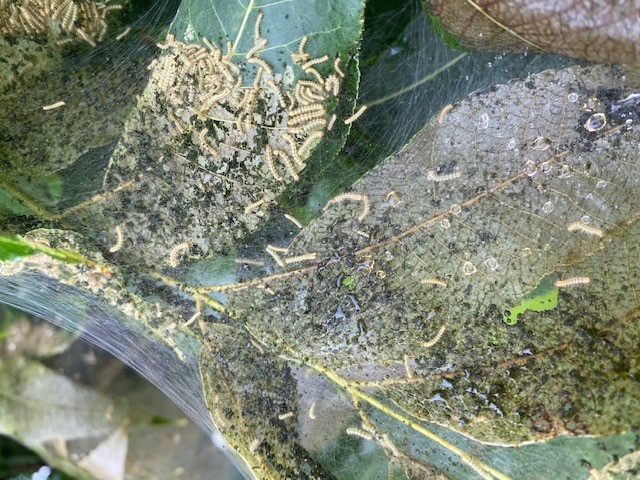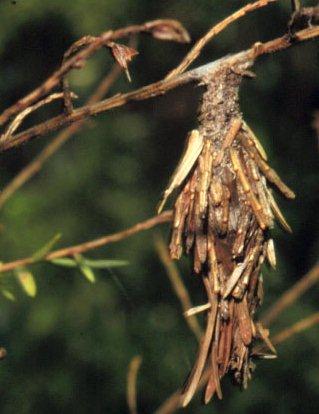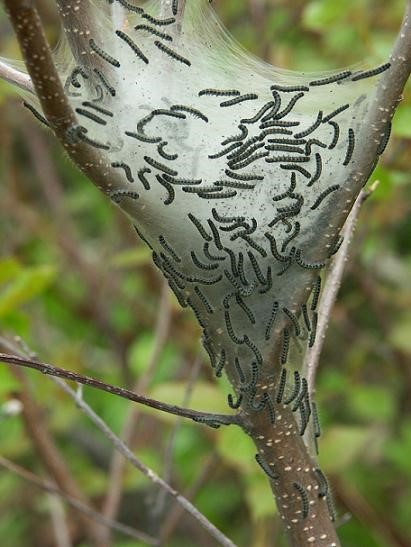By Jessica Strickland, Wayne County Horticulture Extension Agent
As the seasons change and we spend more time observing our landscape trees, many gardeners notice unusual webs, bags, or silk structures appearing on branches. These formations often spark confusion about which pest is causing the problem and how to address it effectively. Understanding the differences between three commonly confused tree pests—fall webworms, bagworms, and Eastern tent caterpillars—can help you implement the most effective management strategies at the optimal time.
Fall Webworms: The Late-Season Web Builders
Fall webworms are perhaps the most visible of these three pests, creating conspicuous webs at the tips of tree branches during late summer and fall. These silky masses contain numerous tiny, hairy caterpillars that work together to create their protective covering. While unsightly, fall webworms typically cause minimal harm to overall tree health.
Identification: Look for large, whitish webs exclusively at the ends of branches, appearing from late summer through fall.
Preferred hosts: Pecan, sourwood, and persimmon trees are favorites, though these adaptable pests can feed on over 600 species of trees and shrubs.
Management: For webs within reach, physical removal is highly effective. Use a stick or pole to pull down the webs, which exposes the caterpillars to natural predators like birds and wasps. If chemical control is necessary, apply carbaryl (Sevin) to the foliage surrounding the web mass rather than directly on the web itself, as direct spraying provides poor contact with the caterpillars. High webs that cannot be reached generally don’t require treatment, as they rarely cause significant damage to tree health.
Bagworms: The Master Camouflagers
Bagworms present a completely different challenge for gardeners. These clever pests construct small, diamond-shaped silk bags that range from 1/8 inch to 2 inches in length. The caterpillars live inside these protective structures and camouflage them with bits of their host plant, making detection difficult.
Identification: Small, diamond-shaped bags hanging from branches, often blending seamlessly with the surrounding foliage.
Preferred hosts: Arborvitae, Leyland cypress, and juniper are particularly susceptible to bagworm infestations.
Management: Hand-picking remains the most effective control method. Carefully clip the bags from tree limbs and dispose of them by drowning in soapy water. For chemical control, timing is crucial—insecticides must be applied in June or early July when the bagworms are small and before their protective bags become impenetrable. Effective insecticides include B.t. (Dipel), carbaryl (Sevin), and malathion.
Eastern Tent Caterpillars: The Spring Web Makers
Eastern tent caterpillars are often mistaken for fall webworms, but several key differences distinguish these pests. Most notably, tent caterpillars create their webs in the center of tree canopies during late spring and early summer, not at branch tips in fall.
Identification: Distinctive black caterpillars with gold or white stripes down their backs, forming webs in tree crotches and central canopy areas during spring.
Preferred hosts: Wild cherry, crabapple, and apple trees are primary targets, though many other tree species can be affected.
Management: Prevention is highly effective with tent caterpillars. Remove and destroy egg masses during winter before caterpillars hatch in spring. Once active, webs can be pulled down with a stick and caterpillars crushed. Trees experiencing several consecutive years of defoliation may show noticeable decline, making early intervention important. Carbaryl (Sevin) provides effective chemical control when needed.
Safety Considerations
Regardless of which pest you’re dealing with, never use fire to destroy webs or bags. This dangerous practice can quickly spread out of control, potentially damaging trees, endangering people, and threatening nearby property.
Timing Is Everything
Successfully managing these tree pests requires understanding their life cycles and implementing control measures at the right time. Fall webworms appear in late summer and fall, bagworms are most vulnerable in early summer, and Eastern tent caterpillars are best controlled through winter egg mass removal or early spring intervention.
By learning to distinguish between these three common tree pests, gardeners can choose the most effective and appropriately timed management strategies. Remember that while these insects can be unsightly and concerning, most healthy trees can tolerate moderate infestations without long-term damage. Focus your control efforts on severe infestations or high-value specimen trees, and always consider environmentally friendly options like physical removal and natural predator encouragement before resorting to chemical controls.
For more gardening information and resources, visit the North Carolina Extension Gardener Plant Toolbox at plants.ces.ncsu.edu or follow Wayne County Cooperative Extension on social media.
Important Note: When using any pesticide products, always read and follow label directions carefully. Ensure that your intended use complies with current regulations and product labeling. The mention of specific brand names does not constitute endorsement, and similar products may be equally effective.





